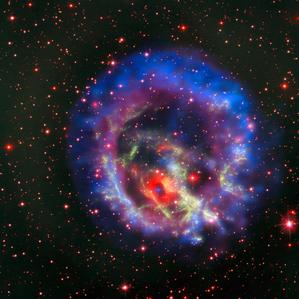Glossary term: Stellar Remnants
Description: "Stellar remnants" is the collective term for white dwarfs, neutron stars, and stellar-mass black holes. These represent the final stage of stellar evolution after a star has both finished hydrogen burning on the main sequence and evolved through the giant phase. Stellar remnants are very compact compared to stars. White dwarfs (the largest type of stellar remnant) have approximately a solar mass of material in an object the size of Earth. Stellar remnants do not generate heat from nuclear fusion in their cores. In close binary systems stellar remnants can be the source of novae, Type Ia supernovae, or (if two stellar remnants spiral towards each other and collide) bursts of gravitational waves.
Related Terms:
- Binary Star
- Black Hole
- Giant Star
- Hydrogen Fusion
- Main Sequence
- Neutron Star
- Nova
- Nuclear Fusion
- Solar Mass
- Star
- Stellar Evolution
- Supernova
- White Dwarf
- Gravitational Waves
- Standard Candle
See this term in other languages
Term and definition status: This term and its definition have been approved by a research astronomer and a teacher
The OAE Multilingual Glossary is a project of the IAU Office of Astronomy for Education (OAE) in collaboration with the IAU Office of Astronomy Outreach (OAO). The terms and definitions were chosen, written and reviewed by a collective effort from the OAE, the OAE Centers and Nodes, the OAE National Astronomy Education Coordinators (NAECs) and other volunteers. You can find a full list of credits here. All glossary terms and their definitions are released under a Creative Commons CC BY-4.0 license and should be credited to "IAU OAE".
Related Media
Death of a massive star
Credit: ESO/NASA, ESA and the Hubble Heritage Team (STScI/AURA)/F. Vogt et al. credit link
License: CC-BY-4.0 Creative Commons Attribution 4.0 International (CC BY 4.0) icons









